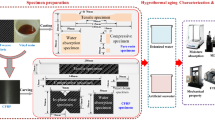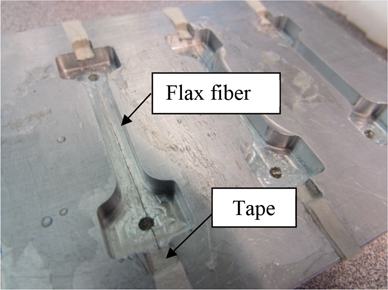Abstract
Degradation of the mechanical properties of vinylester and epoxy matrix composites exposed to water has been approached by monitoring the strengths of glass and carbon fibers and resins. In addition, the fiber/matrix (F/M) interface strengths and debond lengths of single-fiber composites were determined and test results were compared to test results of macroscopic composite specimens. The single-fiber tensile test results indicate a substantial loss of the tensile strength of glass fibers and the fragmentation tests reveal loss of F/M shear strength and substantial debonding for both glass and carbon fiber composites after water exposure. The transverse strengths of the composites are also degraded to large extents. The tests results identify water degradation of the F/M interface as a major strength limiting mechanism.















Similar content being viewed by others
References
Kootsookos A, Mouritz AP (2004) Compos Sci Technol 64:1503. doi:https://doi.org/10.1016/j.compscitech.2003.10.019
Karabhari VM, Zhang S (2003) Appl Compos Mater 10:19. doi:https://doi.org/10.1023/A:1021153315780
Bradley WL (1995) J Mater Sci 30:5537. doi:https://doi.org/10.1007/BF00351570
Pomies F, Carlsson LA, Gillespie JW Jr (1995) ASTM STP 1230, Philadelphia
Springer GS (ed) (1981) Environmental effects on composite materials. Technomic, CA
Verdu J (1984) Water action (In French), in Les Techniques de l’Ingenieur, Volume Plastiques Ref. A 3165, ANFOR, Paris
Augl JM, Berger AE (1976) Proceedings of 8th national SAMPE technical conference, California, p 283
Otto WH (1966) The effects of moisture on the strength of glass fibers—a literature review US Naval Research Lab Contract No. 4522(00)(X) Narmco Division, The Whittaker Corp
Cameron NM (1968) Glass Technol 9:121
Charles RJ (1958) J Appl Phys 29:1549. doi:https://doi.org/10.1063/1.1722991
Charles RJ (1958) J Appl Phys 29:1554. doi:https://doi.org/10.1063/1.1722992
Metcalfe AG, Shcmitz GK (1972) Glass Technol 13:5
Barbero EJ, Damiani TM (2003) J Reinf Plast Compos 22:373. doi:https://doi.org/10.1177/0731684403022004269
Ray BC (2006) J Colloid Interface Sci 298:111. doi:https://doi.org/10.1016/j.jcis.2005.12.023
Rao V, Herra-Franco PJ, Ozzelo AD, Drzal LT (1991) J Adhes 34:65. doi:https://doi.org/10.1080/00218469108026506
Bradley WL, Chiou P, Grant TS (1993) Composite materials for offshore operations. Proceedings of the first international workshop, Texas
Drzal LT, Rich MJ, Koenig MF (1985) J Adhes 18:49. doi:https://doi.org/10.1080/00218468508074936
Schultheisz CR, McDonough WG, Kondagunta S, Shutte CL, Macturk KS, McAuliffe M et al (1996) 13th symposium on composite materials: testing and design
Wagner HD, Lustiger A (1994) Compos 25:613. doi:https://doi.org/10.1016/0010-4361(94)90192-9
Schutte CL, McDonough W, Shioya M, McAuliffe M, Greenwood M (1994) Compos 25:617. doi:https://doi.org/10.1016/0010-4361(94)90193-7
Pomies F, Carlsson LA (1994) J Compos Mater 28:22
Grant TS, Bradley WL (1995) J Comps Mater 29:852
Davies P, Pomies F, Carlsson LA (1996) J Comps Mater 30:1004
Wood CA, Bradley WL (1997) Compos Sci Technol 57:1033. doi:https://doi.org/10.1016/S0266-3538(96)00170-4
Fraga AN, Alvarez VA, Vasquez A (2003) J Comp Mater 37:1553. doi:https://doi.org/10.1177/0021998303029421
Pavlidou S, Krassa K, Papaspyrides CD (2005) J Appl Polym Sci 98:843. doi:https://doi.org/10.1002/app.22179
Feih S, Wonsyld K, Minzari D, Westmann P, Liholt H (2004) Testing procedure for the single fiber fragmentation test. Riso National Laboratory, Riso-R-483(EN) Roskilde, Denmark
Ramirez FA (2008) MS Thesis, Department of Mechanical Engineering, Florida Atlantic University, FL
ASTM D3039M-07 (2007) West Conshohocken, PA
ASTM D790-07 (2007) West Conshohocken, PA
ASTM D638-03 Standard (2003) West Conshohocken, PA
ASTM D4065-06 (2006) West Conshohocken, PA
ASTM D3379-75 (1975) West Conshohocken, PA
ASTM D3171-06 (2006) West Conshohocken, PA
Adams DF, Carlsson LA, Pipes RB (2002) Experimental characterization of advanced composite materials, 3rd edn. CRC Press, Boca Raton
Kelly A, Tyson WR (1965) J Mech Phys Solids 13:329. doi:https://doi.org/10.1016/0022-5096(65)90035-9
Drzal LT, Rich MJ, Camping JD, Park WJ (1980) Proceeding of 35th annual reinforced plastics/composites conference Sect. 20C. The Society of the Plastic Industry, New York, p 1
Weibull WJ (1951) J Appl Mech 18:293
Timoshenko S (1934) Theory of elasticity, McGraw-Hill
Kim BW, Nairn JA (2002) J Compos Mater 36:1825. doi:https://doi.org/10.1177/0021998302036015243
Shen CH, Springer GS (1981) In: GS Springer (ed) Environmental effects on composite materials. Technomic, CA
Adams DF, King TR, Blackketter DM (1990) Compos Sci Technol 39:341. doi:https://doi.org/10.1016/0266-3538(90)90080-O
Acknowledgements
The support of Office of Naval Research (ONR) under contract No. N00014-05-1-0341managed by Dr. Yapa Rajapakse is gratefully acknowledged. Thanks are due to M. Rich and L.T. Drzal of MSU for SFFT advise.
Author information
Authors and Affiliations
Corresponding author
Appendix: analysis of wicking
Appendix: analysis of wicking
Consider a polymer matrix composite. At dry conditions, the weight of the composite, W c,dry, is given by:
where W f and W m are the weights of the fibers and matrix, respectively, in the composite,
where ρ f and ρ m, ν f, and ν m are the fiber and matrix densities and volume fractions, respectively, and V c is the volume of the composite.
At the maximum moisture content, the weight of the composite W c,max, is given by:
where W w,abs is the weight of water absorbed by the composite,
and M c is the composite maximum moisture content. Notice that the composite can absorb water through the matrix and interface,
where W wm and W wi are the weights of the water absorbed by the matrix and interface, respectively. The weight of the water absorbed by the matrix is given by:
where ρ w is the density of water and M m is the maximum moisture content for a neat resin specimen.
Therefore, the weight of water absorbed by the interface (wicking) is given by:
Finally, the weight fractions of the water absorbed through the matrix, w wm, and by wicking, w wi, are given by:
Rights and permissions
About this article
Cite this article
Ramirez, F.A., Carlsson, L.A. & Acha, B.A. Evaluation of water degradation of vinylester and epoxy matrix composites by single fiber and composite tests. J Mater Sci 43, 5230–5242 (2008). https://doi.org/10.1007/s10853-008-2766-z
Received:
Accepted:
Published:
Issue Date:
DOI: https://doi.org/10.1007/s10853-008-2766-z




